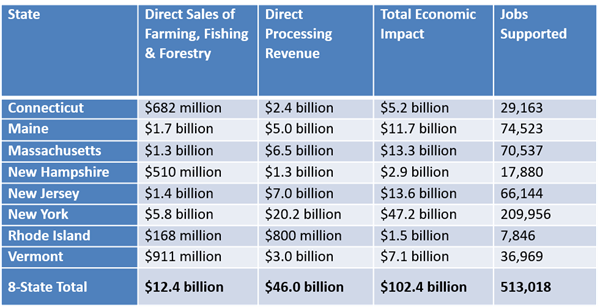December 2, 2020
The Northeast Economic Engine: Agriculture, Forest Products and Commercial Fishing Show $102 Billion in Economic Impact in Northeast
Contents
Volume 14, Issue 12
December 2020
Click here for a PDF version of this month's issue.
The Northeast Economic Engine: Agriculture, Forest Products and Commercial Fishing Show $102 Billion in Economic Impact in Northeast
A report produced by Farm Credit East, in collaboration with researchers from the University of Connecticut’s College of Agriculture, Health and Natural Resources, considered the economic and jobs impacts of agriculture, forest products and commercial fishing in New England, New York and New Jersey.
Using data from the 2017 USDA Census of Agriculture, the US Census Bureau, IMPLAN1 and other sources, the report found that these natural resource-based businesses generated more than $102 billion in economic impact and supported more than 500,000 jobs in the eight Northeast states analyzed. The following chart highlights key economic impact numbers for each Northeast state.
Table 1: 8-State Economic Impact2
This report, Northeast Economic Engine, took direct sales data from the farm, forest products or fishing businesses, combined with processing activities, and used IMPLAN software to calculate the indirect and induced economic impacts and jobs supported throughout the economy.
This economic impact starts at the farm, forest or the dock. Without this primary production in our region, we would not have the jobs and economic impact created by upstream suppliers and downstream processors. This analysis illustrates there are significant numbers of jobs and economic activity from these support and processing businesses which exist in the Northeast primarily because the region’s underlying agricultural production provides the foundation.
The overall economic impact of a given sector is comprised of three components: The direct farm or factory-gate sales of that sector is referred to as the direct impact. The spending of businesses on inputs, goods and services from other firms is referred to as the indirect impact. Finally, the spending of employees of these firms on goods and services within the economy is referred to as the induced impact.
The total economic impact of each farm, fishing and forestry sector is the sum of the direct, indirect and induced impacts of those businesses. Downstream businesses, such as landscaping, wholesaling and retailing other than direct sales from the farm to consumer, were not included. Additionally, food businesses and processors whose primary inputs may not be linked to regional agricultural production, such as bakeries, tropical product handlers, confectionary manufacturing, coffee roasting, grocery retailing, restaurants, etc. were also excluded from the study.
Processing activities that were included were those which the researchers felt were connected to the farming, fishing and forest products production of the region. For example, although raw product may flow into and out of the region, overall, fluid milk processing activity is strongly connected to the milk production of the region’s dairy farms. Thus, the region’s agricultural production contributes broadly to significant economic activity far beyond the farm, forest or fishing dock.
Overall, the top agricultural production sectors across the eight-state region were (note these do not including processing and marketing):
- Dairy cattle & milk production, with $3.9 billion in direct sales, 32% of the region’s total, and $6.7 billion in economic impact;
- Commercial fishing, with $1.6 billion in direct sales and $2.7 billion in economic impact;
- Greenhouse, nursery and floriculture, with $1.5 billion in direct sales and $2.5 billion in economic impact;
- Forestry and logging, with $1.3 billion in direct sales and $2.1 billion in economic impact;
- Vegetable production, with $1.0 billion in direct sales and $1.8 billion in economic impact;
- And fruit farming, with $838 million in direct sales and $1.5 billion in economic impact.
With more than 75,000 farms and over 11 million acres in farmland, more than 60 million acres of forests, and a fishing fleet thousands strong, agriculture, forest products and commercial fishing remain vibrant and essential components of the region’s working landscapes and waterfronts.
To access the full report which contains detailed breakdowns by state and industry sector, click here.
1 The data for this report was created using IMPLAN software (IMPLAN.com), which is a regional economic input-output modeling program used to develop economic impact analysis.
2 Totals do not add due to rounding.
Tags: ag economy, outlook, apple, cash field, dairy, equine, forestry, fruit, greenhouse, lumber, maple syrup production, nursery, timber, vegetable




